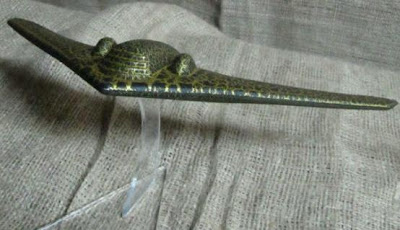 |
| The Pentagon |
(Reuters) - The Pentagon unveiled a 2013 budget plan that would cut $487 billion in spending over the next decade by eliminating nearly 100,000 ground troops, mothballing ships and trimming air squadrons in a bid to create a smaller, agile force with a new strategic focus.
The funding request, which includes painful cuts that will be felt across the country, comes at a historic turning point for the military as it winds down 10 years of war in Afghanistan and Iraq and shifts its strategic focus to the Asia-Pacific region and the Middle East.
The budget plan, sharply criticized by some lawmakers, sets the stage for a new struggle between President Barack Obama's administration and Congress over how much the Pentagon should spend on national security as the country tries to curb its trillion-dollar budget deficits.
"Make no mistake, the savings that we are proposing will impact all 50 states and many districts, congressional districts across America," Defense Secretary Leon Panetta told a news conference at the Pentagon on Thursday.
"This will be a test of whether reducing the deficit is about talk or action."
Panetta, previewing a budget to be made public February 13, said he would ask for a $525 billion base budget for the 2013 fiscal year, the first time since before the September 11, 2001, attacks that the Pentagon has asked for less than the previous year. That compares with $531 billion approved this year.
Panetta said he would seek $88.4 billion to support overseas combat operations, primarily in Afghanistan, down from $115 billion in 2012 largely due to the end of the war in Iraq and the withdrawal of
U.S. forces there at the end of last year.
Congress ultimately controls the Pentagon's purse strings and regularly intervenes to change the size and detail of military spending as it sees fit. The Defense Department's budget accounts for about 20 percent of total federal spending.
Republican lawmakers who oversee military affairs on Capitol Hill sharply criticized the plan.
Senator John McCain said it "ignored the lessons of history" by imposing massive cuts on the military, and Representative Buck McKeon said it reflected "Obama's vision of an America that is weakened, not strengthened, by our men and women in uniform."
MORE CUTS TO COME?
The 2013 budget is Panetta's first as defense secretary and is the first to take into account the Budget Control Act passed by Congress in August that requires the Pentagon to cut $487 billion in projected spending over the next decade.
The budget plan does not take into account an additional $600 billion in defense cuts that could be required after Congress failed to pass a compromise agreement to cut government spending by $1.2 trillion. The Pentagon could face cuts of another $50 billion a year, starting in 2013, unless Congress changes the law.
Panetta said he hoped once lawmakers understood the sacrifice involved in reducing the defense budget by almost a half a trillion dollars, they would make sure to avoid another $500 billion in additional cuts that would "inflict severe damage to our national defense for generations."
The budget begins to flesh out a new military strategy announced by the Pentagon earlier this month that calls for a shift in focus from the ground wars of the past decade towards efforts to preserve stability in the Asia-Pacific region and the Middle East.
"To ensure an agile and ready force, we made a conscious choice not to maintain more force structure than we could afford to properly train and equip," Panetta said.
The budget plan would provide new challenges for the Pentagon's top suppliers, such as Lockheed Martin, Boeing, General Dynamics, Northrop Grumman and Raytheon. The Arca index of defense stocks closed Thursday down 0.7 percent.
The plan retains but slows the purchase of weapons like Lockheed's F-35 Joint Strike Fighter, the Pentagon's largest procurement program, as well as submarines, amphibious assault ships and other vessels. It would retain a fleet of 11 aircraft carriers.
The Pentagon would boost its emphasis on special operations forces like those who carried out the raid in Pakistan that killed al Qaeda leader Osama bin Laden last year and rescued two aid workers this week from kidnappers in Somalia.
It would also increase its emphasis on cyber operations, expand its work on drone aircraft, go ahead with a long-range bomber and proceed with other weapons that would allow it to project power from a greater distance.
Those capabilities are needed as countries like Iran and China develop arms that could threaten
U.S. aircraft carriers in international waters near their shores.
General Martin Dempsey, the top
U.S. military officer as chairman of the Joint Chiefs of Staff, warned against "parsing through each cut, each change, to look for a winner or loser," saying the plan should be judged for how it adapts the military to a changing security environment.
While the cuts announced on Thursday would affect all major defense contractors, consultant Loren Thompson said shipbuilders would be hit particularly hard because of the plan to cut 16 vessels from the total planned for the next five years.
The plans could affect work flow at Huntington Ingalls' shipyards in Pascagoula, Mississippi, and Newport News, Virginia.
The size of the active-duty Army would be trimmed to 490,000 over five years from its wartime peak of 570,000 in 2010 and the size of the Marine Corps would fall to 182,000 from its high of about 202,000.
Military pay increases would begin to slow after two more years of growth, and fees would be increased on healthcare benefits for military retirees, those who served more than 20 years, both above and below the age of 65.
In addition, the Pentagon would:
- Delay development of a new ballistic missile submarine by two years.
- Eliminate six of the Air Force's tactical-air fighter squadrons and retire or divest 130 aircraft used for moving troops and equipment.
- Retire seven Navy cruisers and two smaller amphibious ships early, postpone the purchase of a big-deck amphibious ship by one year and postpone the planned purchase of a number of other vessels for several years.
- Eliminate two Army heavy brigades stationed in Europe and compensate by rotating
U.S. based units into the region for training and exercises.
- Study the possibility of further reducing the size of
U.S. nuclear arsenal.
- Begin a new round of talks on closing bases made unnecessary by the smaller force.




















